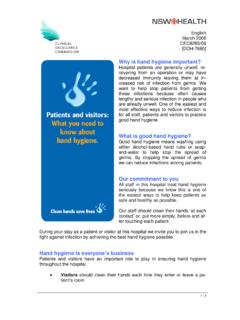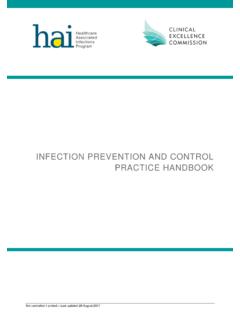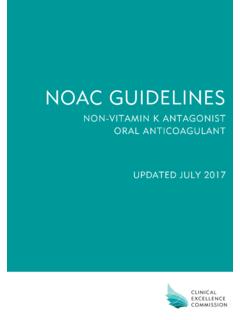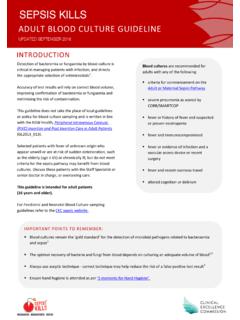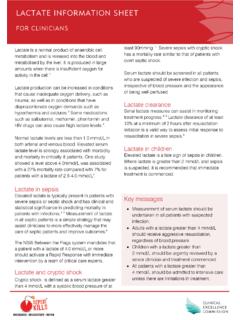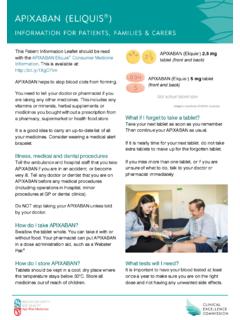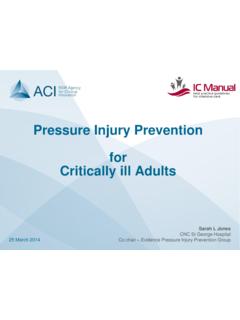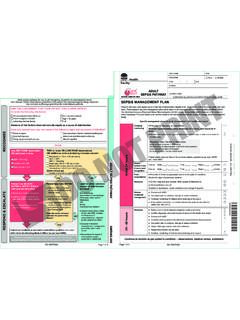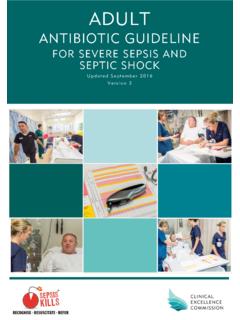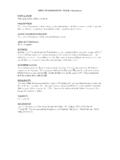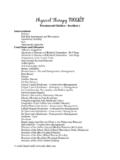Transcription of A guide to understanding balance and mobility for health …
1 A guide to understanding balance and mobility for health staff As people age their balance and mobility reduces. To prevent falls it is important to maintain or improve a person's balance and mobility . This document will provide you with a background to understanding balance and an of balance and mobility tests. These tests will indicate if your client has a balance and mobility issue. Background The maintenance of balance is a highly complex skill whereby the body's centre of mass is controlled within the limits of postural stability. Sensory information coming through the visual, vestibular and somatosensory pathways needs to be integrated and analysed within the central nervous system so that an appropriate motor response can be made. An impairment at any point in this pathway may lead to problems with the maintenance of postural stability which in turn leads to an increase in risk of falls.
2 Different combinations of muscle actions are required to maintain balance when undertaking the variety of everyday tasks we all face (ACSQHC 2009). Impairment in balance is a key predictor of falls risk, therefore we need a variety of tools to reflect the different postural challenges that daily activities present. Conceptually it is helpful to break down the variety of these tasks into four primary actions in which we need to maintain balance : standing, leaning, stepping, and walking (Lord et al 2007). Within these actions it can be noted that there are requirements to maintain balance when stationary (static balance ) as well as requirements to maintain balance when moving (dynamic balance ). Assessment can then be tailored specifically to individual deficits so that appropriate intervention and referral can be planned.
3 Definitions Gait - Human walking, or gait, has been described as the act of falling forward and catching oneself (Magee 1997). Due to the unique physiological challenges that walking presents, there is potential for a loss of balance leading to a fall (Lord et al 2007). Fall A fall is an event which results in a person coming to rest inadvertently on the ground or floor or other lower level' (World health Organisation (WHO) definition of a fall, Best Practice Guidelines for Community Care Preventing Falls and Harm from Falls in Older People, pg 4, (ACSQHC 2009). Static balance the ability to maintain postural stability and orientation with centre of mass over the base of support and body at rest (O'Sullivan and Portney 2014). Dynamic balance the ability to maintain postural stability and orientation with centre of mass over the base of support while the body parts are in motion (O'Sullivan & Portney 2014).)
4 Page 1 of 5. A guide to understanding balance and mobility for health staff balance and mobility assessment tools For those professionals that would like to further assess their clients, there are a range of tools available to assess the specific balance and mobility deficits. Selections of these tools are listed below and in Tables 1 and 2 under the various domains. Standing balance :- Near Tandem Stand Test this test is a measure of balance and ankle strength. The person is asked to stand with their feet in a near tandem position for a period of 10. seconds with eyes closed. Equipment required is a stopwatch and a cm square cardboard template for foot positioning. Test takes less than 5 minutes. Five Times Sit to Stand this is a measure of balance and leg muscle strength and involves timing a person standing up and sitting down from a chair five times, starting with feet in line with knees and arms folded.
5 This test takes less than 5 minutes. Lateral stability: Alternate Step Test this test involves weight shifting and is a measure of lateral stability, requires placing right and left feet (no shoes) as fast as possible on a step 18 cm high and 40 cm deep for 4 repetitions. Stepping balance : Four Square Step Test Test of Dynamic balance that assesses person's ability to step over objects forwards, sideways and backwards. balance during walking: Timed Up and Go This test measures balance , mobility and co-ordination. This is a timed test with the person asked to start from a sitting position in standard chair, stand up and walk 3m as quickly as possible, turn around and walk back and sit down in the chair. Gait Speed this is usually measured over a specific distance on a flat surface from to 10m Tools that measure multiple domains/confidence/efficacy: Short Physical Performance Battery (SPPB) assesses lower extremity function.
6 This test comprises repeated chair stands, tandem stand, side by side stand and m walk. de Morton mobility Index (DEMMI) this measures overall mobility including static and dynamic balance and has shown good validity across from acute and rehab to the community setting. Berg balance Scale measures static balance and falls risk by using 14 separate items. Page 2 of 5. A guide to understanding balance and mobility for health staff Tinetti Performance oriented mobility Assessment (POMA) measures balance and gait using 9 balance and 7 gait measures and takes 10- minutes to administer. Quickscreen falls risk assessment tool assesses lower limb strength, balance and co- ordination as well as other falls risk factors (previous falls, vision, medication, peripheral sensation).
7 Activities Specific balance Confidence ABC measures confidence a person feels carrying out a range of activities of daily living. Modified FES measures confidence a person feels carrying out 14 indoor and outdoor activities (Delbaere et al 2011). iconFES a validated tool that measures fear of falling using pictures to describe a range of activities and situations. Further information on the tools above and links to the tools above are in Tables 1 and 2. Table 1 lists some simple balance and mobility tests, most of these tests can be completed in 5 minutes or less and with minimal equipment. Table 1 Simple balance and mobility tests Assessment What this tool Testing Equipment required Link to test Tool measures time instrument/video Near Tandem Standing balance <3 min cm cardboard Part of SPPB and Stand test and ankle strength square, stopwatch QuickScreen.
8 Five times sit to Standing balance < 3min Chair stand and leg muscle Stopwatch and QuickScreen . strength Alternate Step Strength, balance < 3 min Stopwatch and 18 cm test and coordination step and QuickScreen . Four square step Dynamic balance < 5 min Stopwatch test Four canes Timed up and balance , mobility and < 3 min Stopwatch Go coordination Standard armchair Gait speed Functional mobility , 5 min Stopwatch 10m walk test gait Clear measured pathway Page 3 of 5. A guide to understanding balance and mobility for health staff Table 2 lists more comprehensive balance / mobility and confidence assessment tools and links to further information and the tools. Table 2 Comprehensive balance / mobility and confidence assessment tools Assessment What this tool Testing time Equipment Link to test Tool measures required instrument QuickScreen balance and mobility 10 min All tools included in Clinical Falls and other falls risk kit (stopwatch, Risk assessment factors (including squares string, previous fall, vision chart, medications & vision) monofilament pen Berg balance balance and 30 min Stopwatch Scale functional mobility Chair with armrests using 14 items Measuring tape Object to pick up Step Tinetti balance and gait 10 15 min Stopwatch Performance using 9 balance and Armless chair Oriented mobility 7 gait measures 5 m clear walkway Assessment (uses ).)
9 (POMA). Short Physical balance and gait, 10 minutes Stopwatch Performance strength and Armless chair v/branches/leps/sppb/. Battery (SPPB) endurance De Morton Measures overall 10- 20 min Stopwatch mobility Index mobility including Bed (DEMMI) static and dynamic Chair with armrests balance Pen Activities- Rates balance 10- 20 min Paper Survey/ Specific balance confidence in Pencil or Pen Confidence performing 16. Scale(ABC) ambulatory activities Modified Falls Measure of 5 min Paper Survey/pencil Efficacy scale confidence carrying pen out 14 indoor and outdoor activities icon-FES mobile Measures fear of 5-10 min iPad results can App falling using pictures be downloaded to apps/iconfes/instructions that show a range of computer activities and situations Page 4 of 5.
10 A guide to understanding balance and mobility for health staff References Australian Commission on Safety and Quality in Healthcare (2009) Preventing Falls and Harm from Falls in Older People: Best Practice Guidelines for Australian Community Care. Delbaere, Kim, Smith, Stuart T. and Lord, Stephen R (2011).Development and initial validation of the iconographical Falls Efficacy Scale, J Gerontol A Biol Sci Med Sci 66A (6): 674-680. Lamb, J rstad-Stein, Hauer and Becker (2005). Development of a common outcome data set for fall injury prevention trials: the Prevention of Falls Network Europe Consensus. J Am Geriatr Soc 53: 1618-1622. Lord, Sherrington, and Menz (2007) Falls in Older People: Risk Factors and Strategies for Prevention (2nd Edition): Cambridge University Press.
